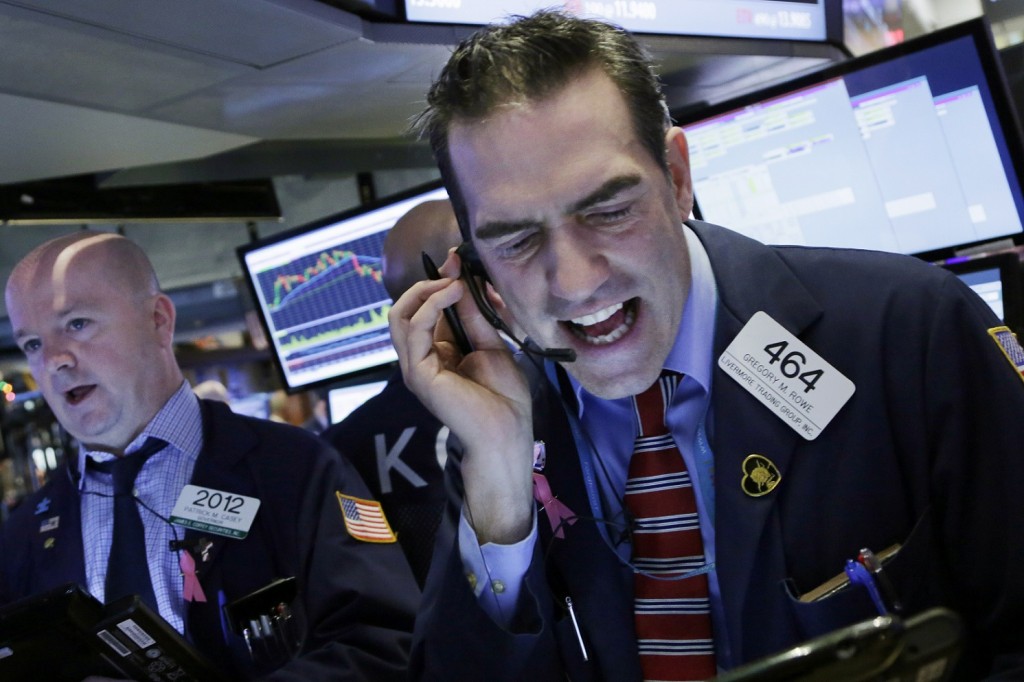- California Assembly OKs highest minimum wage in nation
- S. Korea unveils first graphic cigarette warnings
- US joins with South Korea, Japan in bid to deter North Korea
- LPGA golfer Chun In-gee finally back in action
- S. Korea won’t be top seed in final World Cup qualification round
- US men’s soccer misses 2nd straight Olympics
- US back on track in qualifying with 4-0 win over Guatemala
- High-intensity workout injuries spawn cottage industry
- CDC expands range of Zika mosquitoes into parts of Northeast
- Who knew? ‘The Walking Dead’ is helping families connect
Stock market slides again; worst two-week start to a year

Stock trader Gregory Rowe works at the New York Stock Exchange, Friday, Jan. 15, 2016. (AP Photo/Mark Lennihan)
*This article has been updated.
(AP) — Never before has Wall Street gotten off to a worse start to a year.
The stock market capped the first two weeks of 2016 with a steep slide Friday that sent the Dow Jones industrial average down nearly 400 points.
All three major stock indexes — the Dow, the Nasdaq composite index and the Standard & Poor’s 500 — are now in what’s known as a correction, or a drop of 10 percent or more from their recent peaks.
The Dow and S&P 500 have now fallen about 8 percent this year, while the Nasdaq is off about 10 percent.
“Oil is the root cause of today,” said Dan Farley, regional investment strategist at the Private Client Reserve at U.S. Bank. “People are uncertain, and when they’re uncertain they’re scared.”
Crude oil has dropped below $30 a barrel from a high of over $100 during the summer of 2014, eviscerating energy company profits. On Friday, Williams Cos. led a slide among oil, gas and mining companies, falling $2.19, or 12 percent, to $16.10.
Investors also got some discouraging economic news on Friday: The Federal Reserve said U.S. industrial production, which includes manufacturing, mining and utilities, dropped in December for the third month in a row. And another government report indicated U.S. retail sales dipped last month.
Many investors had welcomed the new year with fairly high hopes. They expected oil prices would stabilize. After a market correction in August, few forecast it would happen again so soon. And the Federal Reserve’s move in December to raise interest rates for the first time in nearly 10 years signaled to many that the U.S. economy was healthy.
“The hope was global growth would stabilize, and early in 2016 here, that has been a disappointment, too,” said David Chalupnik, head of equities at Nuveen Asset Management.
Despite the rough start to the year, Wall Street watchers are not ready to say that the bull market is over.
“We don’t believe we’re going into a bear market,” Chalupnik said. “The reason for that is the U.S. economy is sound.”
Intel dropped 9.1 percent after the chipmaker posted its fourth-quarter results, noting its personal computer business continues to slump. The stock was the biggest decliner in the Dow. It fell $2.98 to $29.76.
Benchmark U.S. crude fell $1.78, or 5.7 percent, to $29.42 a barrel in New York. Brent crude, a benchmark for international oils, fell $1.94, or 6.3 percent, to $28.94 a barrel in London.
Stocks opened higher in Europe but quickly fell. Germany’s DAX lost 2.5 percent, while France’s CAC 40 dropped 2.4 percent. Britain’s FTSE 100 fell 1.9 percent.
In China, the Shanghai Composite Index slid 3.6 percent to its lowest close in 13 months. China’s official Xinhua News Agency reported that new bank loans during the last month fell from a year earlier, another sign that the country’s economic growth is slowing from the torrid pace of the past few years.
Hong Kong’s Hang Seng dropped 1.5 percent. Japan’s Nikkei 225 lost 0.5 percent and South Korea’s Kospi 1.1 percent.
In other energy trading, wholesale gasoline fell 5 cents to close at $1.02 a gallon, heating oil fell 5 cents to close at 93 cents a gallon, and natural gas fell 4 cents to close at $2.10 per one thousand cubic feet.
Precious and industrial metals futures closed mixed. Gold rose $17.10 to $1,090.70 an ounce, silver gained 15 cents to $13.90 an ounce and copper fell 3 cents to $1.94 a pound.
Bond prices rose. The yield on the 10-year Treasury note fell to 2.03 percent from 2.09 percent late Thursday. The euro rose to $1.0911 from $1.0862, while the dollar fell to 117.05 yen.
















d--h.info
January 15, 2016 at 8:10 PM
Milwaukee Journal Sentinel – Official Site